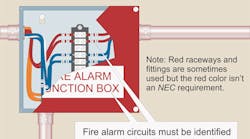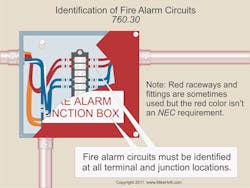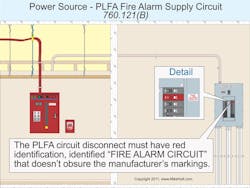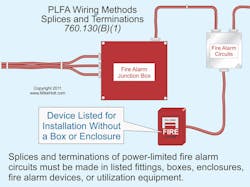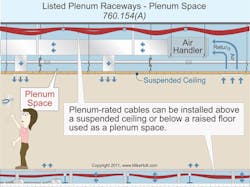Article 760 covers the installation of wiring and equipment for fire alarm systems, including circuits controlled and powered by the fire alarm system. These include fire detection and alarm notification, voice communications, guard’s tour, sprinkler water flow, and sprinkler supervisory systems. These don’t include residential smoke alarm systems because they aren’t powered by a fire alarm system as defined in NFPA 72.
Other articles
Fire alarm circuits must comply with 760.3(A) through (K). Only the sections of Art. 300 mentioned here apply to alarm circuits and equipment:
(A) Spread of fire or products of combustion. Fire alarm circuits installed through fire-resistant-rated walls, partitions, floors, or ceilings must be firestopped to limit the possible spread of fire or products of combustion per the instructions supplied by the manufacturer for the specific type of cable and construction material [300.21].
(D) Corrosive, damp, or wet locations. Fire alarm circuits installed in corrosive, damp, or wet locations must be identified for use in the operating environment [110.11], must be of materials suitable for the environment, and must be of a type suitable for the application [310.10(G)].
(H) Raceways or sleeves exposed to different temperatures. If a raceway or sleeve is subjected to different temperatures — and where condensation is a known problem — the raceway or sleeve must be filled with a material (approved by the AHJ) that will prevent the circulation of warm air to a colder section of the raceway [300.7(A)]. An explosionproof seal isn’t required for this purpose.
(J) Number and size of conductors in a raceway. Raceways must be large enough to permit the installation and removal of conductors without damaging conductor insulation [300.17]. When all conductors in a raceway are the same size and insulation, you can find the permitted number of conductors in Annex C for the raceway type.
(K) Bushing. When running cables in a raceway, you must reduce the potential for abrasion by placing a bushing at the location where the cables enter the raceway [300.15(C)].
Article 725 or Art. 760 might also apply:
(E) Building control circuits. Class 1, 2, and 3 circuits used for building controls (elevator capture, fan shutdown, etc.), associated with the fire alarm system but not controlled and powered by the fire alarm system, must be installed per Article 725 [760.1].
(F) Optical fiber cables. Optical fiber cables used for fire alarm circuits must be installed per Art. 770.
Mechanical execution
Install equipment and cabling in a neat and workmanlike manner [760.24]. One aspect of this is locating cables so the suspended-ceiling panels can be moved to provide access to electrical equipment [760.21].
Support exposed cables by the structural components of the building so the cable won’t be damaged by normal building use. Secure cables using straps, staples, hangers, cable ties, or similar fittings in a manner that won’t damage the cable. You can support raceways and cables by independent support wires attached to the suspended ceiling [300.11(A) and 760.46].
Cables installed through (or parallel to) framing members or furring strips must be protected if they’re likely to be penetrated by nails or screws. Protect them:
• By installing the wiring method so it’s at least 1¼ in. from the nearest edge of the framing member or furring strips, or
• With a 1⁄16-in.-thick steel plate (or the equivalent) [300.4(D)].
Abandoned cable
The accessible portion of cable that isn’t terminated at equipment — and not identified for future use with a tag — must be removed [760.25]. Cables installed in concealed raceways aren’t considered “accessible,” so you don’t have to remove them. If a cable isn’t terminated because it’s for future use, identify it with a tag that can withstand the environment.
Fire alarm circuits
At terminal and junction locations, make sure you identify the fire alarm circuits [760.30]. This rule exists to help prevent unintentional signals on the fire alarm system circuits during servicing of other systems (Fig. 1). If twisted-pair power-limited fire alarm circuit conductors extend beyond a building, install them per Art. 800 or per Part I of Art. 300 [760.32].
Power-limited circuits
Power-limited fire alarm (PLFA) equipment must be supplied by a branch circuit that supplies no other load and isn’t GFCI or AFCI protected [760.121(B)]. The location of the branch circuit overcurrent device for the PLFA must be permanently identified at the fire alarm control unit. The branch circuit overcurrent device must be identified in red, accessible only to qualified personnel, and identified as “FIRE ALARM CIRCUIT.” The red identification must not damage the overcurrent protective device or obscure any manufacturer markings (Fig. 2). Fire alarm equipment supplying PLFA cable circuits must be durably marked to indicate each circuit that’s a PLFA circuit [760.124].
If you’re installing PLFA conductors and cables described in 760.179 (see PLFA Cable Listing and Marking) in exposed or fished concealed spaces, make your cable splices or terminations in listed fittings, boxes, enclosures, fire alarm devices, or utilization equipment [760.130]. In addition, ensure it is adequately supported and protected against physical damage (Fig. 3).
Mix or separate?
Don’t place PLFA conductors in any enclosure, raceway, or cable with conductors of electric light, power, or Class 1 circuits [760.136(A)]. But you can run PLFA circuit cables with Class 1, non-power-limited fire alarm and medium-power network-powered broadband circuits if they are separated by a barrier [760.136(B)].
You can also run PLFA conductors with electric light, power, and Class 1 circuit conductors in enclosures where these other conductors are introduced solely for connection to the same equipment. But you must maintain a minimum of ¼ in. separation from the PLFA conductors.
Separate PLFA conductors by at least 2 in. from insulated conductors of electric light, power, or Class 1 circuits unless those conductors are in a raceway or in metal-sheathed, metal-clad, nonmetallic-sheathed, or underground feeder cables.
PLFA circuits, communications circuits, or Class 3 circuits can be in the same cable, enclosure, cable tray, or raceway [760.139].
Class 2 circuits can be within the same cable, enclosure, cable tray, or raceway as conductors of PLFA circuits if the Class 2 circuit conductor insulation isn’t less than that required for the PLFA circuit.
You can’t install audio system circuits [640.9(C)] using Class 2 or Class 3 wiring methods in the same cable, cable tray, or raceway with PLFA conductors or cables. However, this restriction doesn’t apply to the voice annunciation audio circuits supplied and controlled from a fire alarm panel and commonly required in high-rise buildings and similar applications.
Ducts and plenums
You can install PLFA cables in ducts, if:
• Necessary for direct action upon or sensing of the contained air.
• Installed in a metal raceway per 300.22(B).
You can install PLFA cables in plenums if they’re plenum rated. If they are not, you can install the cables in a plenum if you run them in metal raceway [300.22(C)(1)], as shown in Fig. 4. Cables that are plenum rated can be installed in plenums, but they can’t be installed in ducts. Listed raceways that are plenum rated can be installed in a plenum space [300.22(C)(3)] if the cables contained in these raceways are suitable for plenum use.
PLFA cables installed in vertical runs penetrating more than one floor must be riser-rated Types FPLR or FPLP [760.179(E)]. You can install listed riser raceways and listed plenum signaling raceways in vertical riser runs if the cables contained in these raceways are Types CL2R, CL3R, CL2P, or CL3P. PLFA cables installed in vertical runs penetrating more than one floor don’t need to be riser-rated if installed within a metal raceway. You can make PLFA circuit cables substitutions per Table 760.154.
Communication breakdown
A fire alarm system is a communication system, albeit a specialized one. Many Art. 760 requirements match communications system requirements covered in Chapter 8. However, the life-saving mission of a fire alarm system means it has additional requirements so there’s not a communication breakdown at a critical time. If you’re unsure about what to do when applying Art. 760, thinking of its mission will help you make the right decisions.
SIDEBAR: PLFA Cable Listing and Marking
PLFA cable installed within buildings must be listed and marked for the following [760.179]:
• Conductors must be solid or stranded copper.
• Conductors in a multiconductor cable must be at least 26 AWG.
• Single conductors must be at least 18 AWG.
• The cable voltage rating must be at least 300V. To avoid application this rating must not be marked on the cable [760.176(C)].
Also, coaxial cables are listed as:
• Type FPLP, for use in plenums [760.154(A)].
• Type FPLR, for use in a vertical run in a shaft or from floor to floor [760.154(B)].
• Type FPL, for general-purpose use [760.154(C)].
